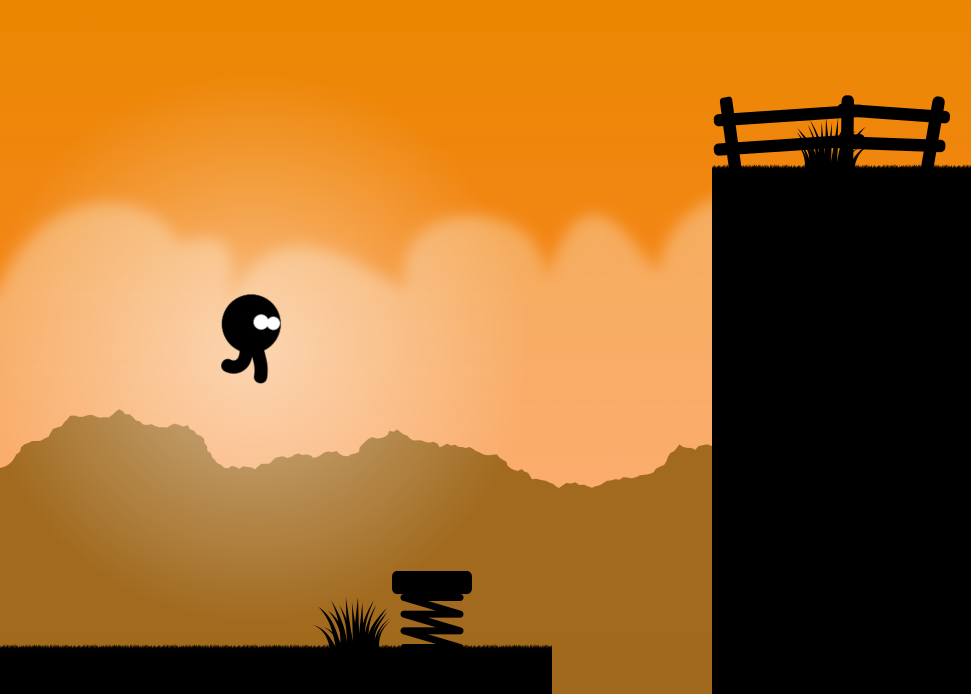Abstract
Ei is a two-dimensional platform game created for the purpose of studying procedural generated levels in platform games. The game features a level editor, which incorporates the ability to generate levels through an inbuilt code editor. The resulting levels can be further modified by human interaction. A simple level generator was implemented for this level editor and this report describes how that generator works.
Introduction
Procedural content generation has been employed in several aspects of video game design. A wide variety of tools and techniques exist to help designers generate content like textures (Spiral Graphics Inc. 2012) , cities (Esri 2014), trees (Interactive Data Visualization, Inc. 2012) and other natural features. In certain applications, content such as game worlds, levels and stories (Pierce 2010) are generated in real-time to give the player a unique experience anytime they play. In this report, the focus would be entirely on procedural level generation.
Rogue, a genre defining dungeon crawler, was responsible for the earliest known level generator. The designers of Rogue wanted to create a game that would provide a new adventure any time it was played (Wichman 1997). Their technique although simple, was rather intuitive and very revolutionary for the time; it involved splitting the world up into dungeons, linking up the dungeons and littering the dungeons with enemies and loot. The level generation concepts found in Rogue have successfully been applied to newer games such as Diablo II and Civilization.
Unlike role player games and dungeon crawlers, platform games provide a different kind of challenge to level generators. Physics constraints, placement of game objects and certain domain specific characteristics of the game for which the levels are being generated, provide several new dimensions that level generators need to consider when generating content (Compton and Mateas 2006). One area concerning procedural level generators that has experienced a lot of research interest is the evaluation of the properties of the content generated by a given generator. Due to the fact that platform level generators posses the ability to generate a large number of content in a short space of time, visual analysis and other informal approaches may prove inadequate for the purpose of evaluating generators. To solve this problem, researchers have devised metrics such as linearity, leniency, density, pattern density, pattern variation and a collection of others to help in quantitatively measuring the properties of levels generated (Canossa and Smith 2015; Gillian Smith and Whitehead 2010; Horn et al. 2014). It is also worth noting that whatever content generators produce would ultimately be used by humans. Therefore, to judge the quality of levels from the human perspective, researchers have found ways of either incorporating human feedback into measurement techniques (N. Shaker et al. 2011) or artificially modeling the behaviour of human players when analyzing generated content (Hoeft and Nieznańska 2014). With the ability to evaluate level generators, specific generators can be created to meet specific design goals (Gillian Smith and Whitehead 2010; Noor Shaker, Smith, and Yannakakis 2015).
Meet Ei
Ei is a two-dimensional, tile-based platform game featuring a titular character (called Ei). Like in most platform games, Ei has the ability to run on platforms, jump over gaps, pick up collectibles and avoid enemies. Visually Ei features silhouette style graphics where the characters and other game objects are completely dark and are presented over a brightly coloured background.

A level editor is incorporated into the game to make it possible for levels to be created and played. Given that Ei was primarily built for the purpose of experimenting with level generators, the level generator features a code editor which makes it possible to provide logic for level generation. It also includes a simple evaluation toolkit which is capable of generating a large number of levels to help determine the expressive range of a given level generator.
To test the level generator and its code editor, a simple level generator was implemented. This generator uses an approach similar to that found in the Infinite Super Mario Brothers game. The levels are generated by randomly placing level sections side by side. The rest of this report explains how this particular generator works.
The Random Generator
The Random level generator generates levels by piecing together pre-designed level sections from left to right. There are a total of five such sections. These are: flat grounds, gaps, gaps with spikes, elevated platforms, spring jumps and flat grounds with retractable spikes. The chance of any of these sections occurring at any point during generation is biased by a difficulty parameter. This difficulty parameter can have an integer value ranging from one (1) to ten (10). A higher difficulty value would increase the odds by which sections that are expected to be difficult to play are selected.
Another consideration made during the generation of the levels, is the order in which level sections are placed after each other. Placing certain sections directly in the same place might create levels that cannot be played. An example of such an incident would be placing a wide gap after another gap. Obviously, this would generate a gap which cannot be cleared by the player and effectively render the level un-playable.
More on the sections
Although pre-designed, the various level sections are in certain ways parameterized. This means that, outputs of the various sections are variable to a certain extent. To further ensure that a generated level is playable, extra checks are performed when rendering sections. The basic premise of most of these checks are the constraints imposed by the physics engine on the movement Ei. With a long press of the jump button, Ei has the ability to jump up to 3.2 tiles high. When moving at full velocity, Ei can jump forward over 5.2 tiles when the jump button is pressed for a long time. Placement of enemies and collectibles are inherently determined during the generation of individual sections. Following are brief descriptions of each of the sections.





Flat Ground
Flat grounds extend from the base of the level to a given platform height. The platform height value is initially determined at the start of generation and is continually varied as sections are appended to the level. The extent to which the platform height value is varied is also influenced by the value of the difficulty parameter. By varying the height value up or down in a random manner, the effect of a stepped platform is generated.
Lengths of flat grounds are randomly chosen to be from three (3) to six (6) tiles. Flat grounds can contain enemies. The chances of an enemy appearing on a flat ground is biased such that, flat grounds for levels with higher difficulty values have higher chances of containing enemies. A flat ground may also contain collectibles across its length. The chances of this occurring is 50% irrespective of the current value of the difficulty parameter. For purposes of aesthetics, flat grounds could either be decorated with grass bushes, lamp posts or wooden fences. The surface of the flat ground could also be rough, covered with grass or smooth.
Gaps
Gaps are empty spaces between the platform through which Ei can fall and die. They can have a length which ranges from one (1) to five (5) tiles. In order to vary their appearance and add different twists to the level generated, gaps may have spikes at the bottom. Whereas Ei would fall directly through an open gap, gaps with spikes on the bottom will have Ei colliding with the spikes and bouncing off to death. Levels with higher difficulty parameters are biased to have more. Gaps in such sections will also be biased to have longer gaps.
Elevated Platforms
Elevated platforms are platforms which are raised three tiles above the current platform height with a space underneath. They have a high chance of containing collectibles. For levels generated with a higher difficulty parameter, the chances of an enemy on the platform is high. The flat ground found under the elevated platform is generated with the same logic as used for plain flat grounds. Elevated platforms have their lengths ranging from three (3) to six (6) tiles. Just like flat grounds, the surfaces of elevated platforms could be rough, covered with grass or smooth.
Spring Jumps
Spring jumps provide a spring, which propels Ei to jump higher (up to 8.5 tiles). These jumps provide a gap which can have a length that ranges from one (1) to four (4) tiles long. The gap is immediately followed either by a flat ground or a raised platform which has a height that is five (5) to eight (8) tiles higher than current platform. The length of the higher platform ranges from five (5) to nine (9) tiles. The gap provided by the spring jump, cannot be cleared by the player without the assistance of the spring.
Retractable Spikes
Retractable spikes are flat grounds which contain killer spikes that periodically retract into and poke out of the ground. The ground is completely harmless when the spikes are underneath. Ei would however die when he collides with the spikes. Spikes could appear in groups of one (1) to five (5) and they alternate their state every three (3) seconds. The player has to study the timing of the spikes while moving to avoid getting killed.
Evaluating the Generator
Evaluation of procedural generated content is key in understanding the properties of a given generator. It also gives a good idea of how a given generator responds to a particular set of inputs it receives. With the ability to generate a large number of unique levels in a short space of time, it is impossible to visually evaluate all levels generated to ensure that the generator is performing as desired. A great way to analyze the properties of a generator is to evaluate its expressive range. The expressive range provides a representation of all content a particular generator is capable of generating. It also goes ahead to show how different inputs to a generator affect its output and how biased a particular generator is to generating a particular kind of content (Noor Shaker, Smith, and Yannakakis 2015).
Expressive Range
In determining the expressive range of the Random Level generator, the approach proposed by Smith and Whitehead (Gillian Smith and Whitehead 2010) was applied. This approach involves: determining an appropriate set of metrics, generating a large amount of content, visualizing the scores of the metrics for the content sample space generated and analyzing the impact of parameters on the output of the generator.
With respect to the selection of metrics for the purposes of evaluating the Random Level generator, linearity and leniency were selected. Linearity measures the “profile" of generated levels, whiles leniency gives a measure of how forgiving a generated level is likely to be to a player. Linearity is more of an aesthetic metric and leniency tries to give a portrayal of the difficulty of a given level. See (Gillian Smith and Whitehead 2010) for a formal definition of both linearity and leniency.
To compute linearity, a best fit line which passes through the level is computed, using the centre points of each platform as data points. A normalized sum of absolute displacements of the centre points from the best fit line is then computed and divided by the total number of center points to get the value of the linearity. Lower values of linearity indicate levels of a more linear “profile".


Leniency is computed by taking into account parts of the layout of a level that require the user to perform some kind of action (e.g. jump over a gap). Scores which reflect an intuitive measure of how lenient a given action would be are assigned to each action. For the purposes of this report, the following scores were assigned to actions Ei could perform:
- 1 for jumps which are not over gaps.
- 0.5 for spring jumps.
- -0.5 for retractable spikes.
- -1 for jumps over gaps.
The normalized sum of these scores was divided by the total number of scores to get the leniency of a given level. Higher values indicate levels which are more lenient. See Figure [fig:level] for sample levels with different linearity and leniency values.
For the evaluation of the Random Level generator, a sample space with a total of 20,000 levels were generated for each value of difficulty. With each level generated, the linearity and leniency were respectively computed. To visualize the expressive range a two dimensional histogram as suggested by Smith and Gillian was plotted for the two selected metrics. See Figure [fig:heatmaps] for the histograms generated for difficulty values of 1, 5 and 10.



Looking at the generated graphs it is clear how the difficulty parameter significantly affects the value of leniency. Levels tend to have less leniency with higher values of the difficulty parameter. Linearity on the other hand remains quite constant with a slight increase as the difficulty parameter increases.
Conclusion
This report described a random level generator that was implemented for a simple platform game called Ei. Ei’s random level generator is very simple, as far as level generators for two dimensional platform games are concerned. Its output lacks variation and gets repetitive for very long levels. The research community around level generators for platform games have developed a number of level generators which use a variety of techniques to generate levels to meet different design goals. Some level generators use evolutionary algorithms to evolve levels to meet certain fitness criteria (Dahlskog and Togelius 2014), and others also exploit rhythms to engage players(G. Smith et al. 2011). There are even level generators that are built to adapt to the individual playing styles of players.
References
Canossa, Alessandro, and Gillian Smith. 2015. “Towards a Procedural Evaluation Technique: Metrics for Level Design.” In.
Compton, Kate, and Michael Mateas. 2006. “Procedural Level Design for Platform Games.” In AIIDE, edited by John E. Laird and Jonathan Schaeffer, 109–11. The AAAI Press.
Dahlskog, Steve, and Julian Togelius. 2014. “Procedural Content Generation Using Patterns as Objectives.” In Applications of Evolutionary Computation, edited by Anna I. Esparcia-Alcázar and Antonio M. Mora, 8602:325–36. Lecture Notes in Computer Science. Springer Berlin Heidelberg.
Esri. 2014. “CityEngine.” http://www.esri.com/software/cityengine.
Hoeft, Robert, and Agnieszka Nieznańska. 2014. “Empirical Evaluation of Procedural Level Generators for 2D Platform Games.” Master’s thesis, SE-371 79 Karlskrona Sweden: Blekinge Institute of Technology.
Horn, Britton, Steve Dahlskog, Noor Shaker, Gillian Smith, and Julian Togelius. 2014. “A Comparative Evaluation of Procedural Level Generators in the Mario AI Framework.”
Interactive Data Visualization, Inc. 2012. “SpeedTree.” http://www.speedtree.com.
Pierce, Shay. 2010. “Story-Generating Games.” 2010.
Shaker, Noor, Gillian Smith, and Georgios N. Yannakakis. 2015. “Evaluating Content Generators.” In Procedural Content Generation in Games: A Textbook and an Overview of Current Research, edited by Noor Shaker, Julian Togelius, and Mark J. Nelson. Springer.
Shaker, N., J. Togelius, G. N. Yannakakis, B. Weber, T. Shimizu, T. Hashiyama, N. Sorenson, et al. 2011. “The 2010 Mario AI Championship: Level Generation Track.” Computational Intelligence and AI in Games, IEEE Transactions on 3 (4): 332–47.
Smith, Gillian, and Jim Whitehead. 2010. “Analyzing the Expressive Range of a Level Generator.” In Proceedings of the 2010 Workshop on Procedural Content Generation in Games, 4:1–7. PCGames ’10. New York, NY, USA: ACM.
Smith, G., J. Whitehead, M. Mateas, M. Treanor, J. March, and Mee Cha. 2011. “Launchpad: A Rhythm-Based Level Generator for 2-d Platformers.” Computational Intelligence and AI in Games, IEEE Transactions on 3 (1): 1–16.
Spiral Graphics Inc. 2012. “Genetica.” http://www.spiralgraphics.biz/genetica.htm.
Wichman, Glenn R. 1997. “A Brief History of “Rogue".” 1997. http://www.wichman.org/roguehistory.html.
